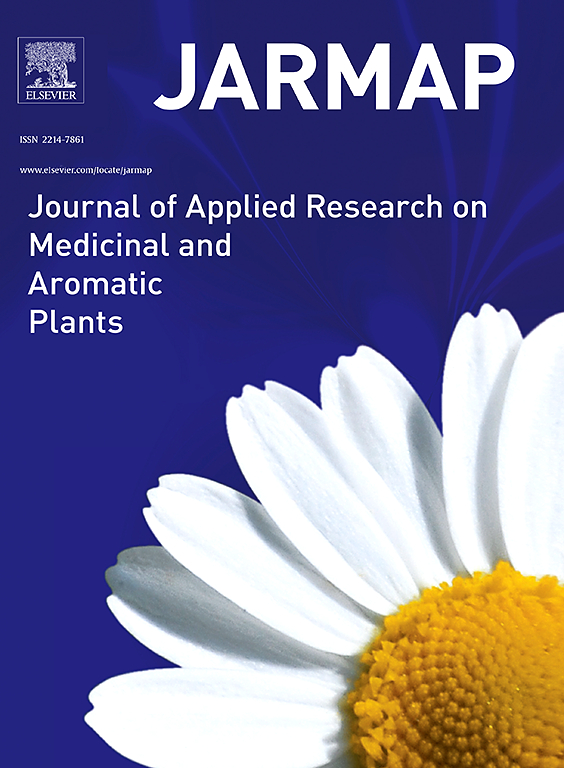伊朗药用植物中的重金属污染:来源、分布和健康影响的综述
IF 3.6
2区 农林科学
Q1 PLANT SCIENCES
Journal of Applied Research on Medicinal and Aromatic Plants
Pub Date : 2025-04-01
DOI:10.1016/j.jarmap.2025.100637
引用次数: 0
摘要
环境污染,特别是重金属污染,是评估药用植物质量的一个关键问题。这些植物体内重金属的浓度与生长环境、种类、加工方法等因素有关。被植物吸收的污染物可以通过食用进入人体。本文综述了重金属镉(Cd)、铅(Pb)、砷(As)、铜(Cu)、铬(Cr)、锌(Zn)和镍(Ni)对伊朗药用植物的影响。它探讨了环境污染如何影响植物质量,并分析了测量技术和金属浓度随时间的变化趋势。结果表明,镉对植物生长的影响最显著(63 %),其次是Pb(21 %)、Cr(11 %)和Zn(5 %)。样品中镉超标的比例为47. %,铅和锌超标的比例分别为26. %和20. %。Cd和Pb也显著降低了发芽率。镉和铅污染会带来严重的健康风险,包括肾损伤、骨骼疾病、癌症、神经问题和生殖危害。严格的质量控制、可持续农业和公众意识对于减轻这些风险至关重要。这项研究强调需要进一步研究,特别是在德黑兰、胡泽斯坦、伊斯法罕和法尔斯等工业区,以确保药用植物的安全。本文章由计算机程序翻译,如有差异,请以英文原文为准。
Heavy metal pollution in Iranian medicinal plants, a review of sources, distribution, and health implications
Environmental pollution, particularly with heavy metals, is a critical issue in assessing the quality of medicinal plants. The concentration of heavy metals in these plants depends on factors such as growth environment, species, and processing methods. Contaminants absorbed by plants can enter the human body through consumption. This review examines the impact of heavy metals—cadmium (Cd), lead (Pb), arsenic (As), copper (Cu), chromium (Cr), zinc (Zn), and nickel (Ni)—on medicinal plants in Iran. It explores how environmental contamination affects plant quality and analyzes trends in measurement techniques and metal concentrations over time. Results show that Cd has the most significant negative impact on plant growth (63 %), followed by Pb (21 %), Cr (11 %), and Zn (5 %). Cd exceeded WHO limits in 47 % of samples, while Pb and Zn exceeded limits in 26 % and 20 %, respectively. Cd and Pb also significantly reduced germination rates. Contamination with Cd and Pb poses serious health risks, including kidney damage, bone disorders, cancer, neurological issues, and reproductive harm. Strict quality control, sustainable farming, and public awareness are essential to mitigate these risks. This study highlights the need for further research, particularly in industrial regions like Tehran, Khuzestan, Isfahan, and Fars, to ensure the safety of medicinal plants.
求助全文
通过发布文献求助,成功后即可免费获取论文全文。
去求助
来源期刊

Journal of Applied Research on Medicinal and Aromatic Plants
Pharmacology, Toxicology and Pharmaceutics-Drug Discovery
CiteScore
6.40
自引率
7.70%
发文量
80
审稿时长
41 days
期刊介绍:
JARMAP is a peer reviewed and multidisciplinary communication platform, covering all aspects of the raw material supply chain of medicinal and aromatic plants. JARMAP aims to improve production of tailor made commodities by addressing the various requirements of manufacturers of herbal medicines, herbal teas, seasoning herbs, food and feed supplements and cosmetics. JARMAP covers research on genetic resources, breeding, wild-collection, domestication, propagation, cultivation, phytopathology and plant protection, mechanization, conservation, processing, quality assurance, analytics and economics. JARMAP publishes reviews, original research articles and short communications related to research.
 求助内容:
求助内容: 应助结果提醒方式:
应助结果提醒方式:


